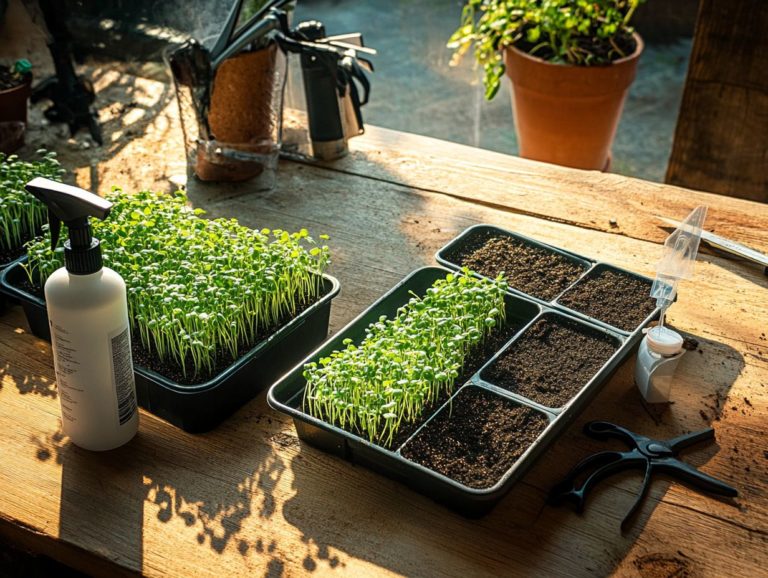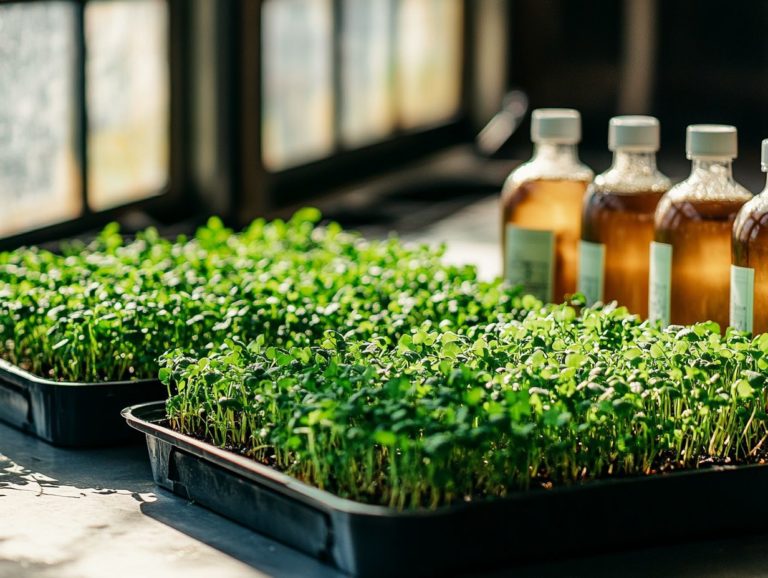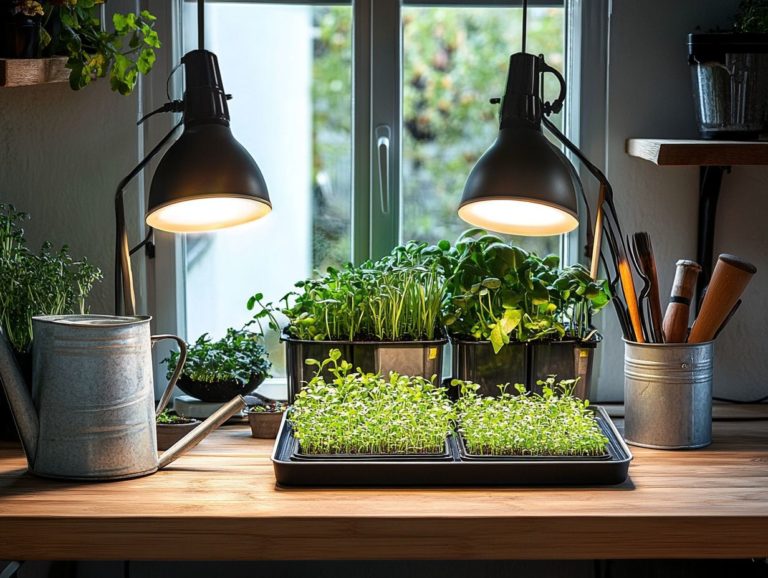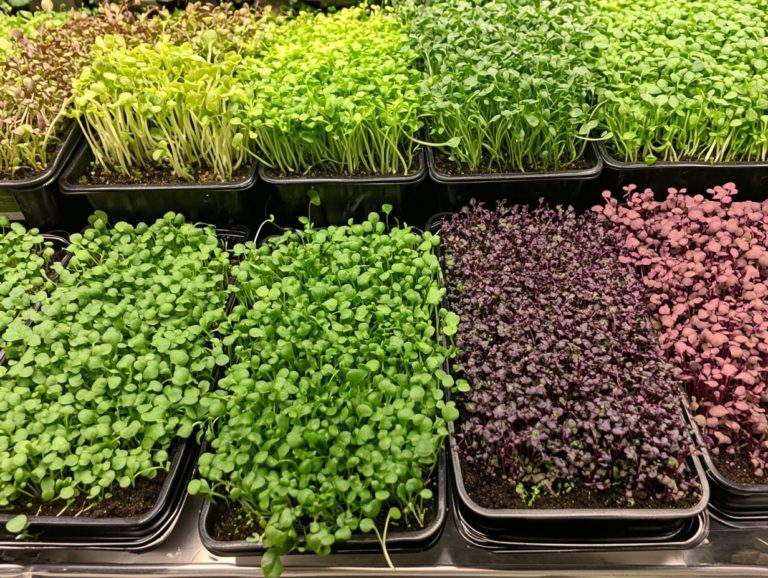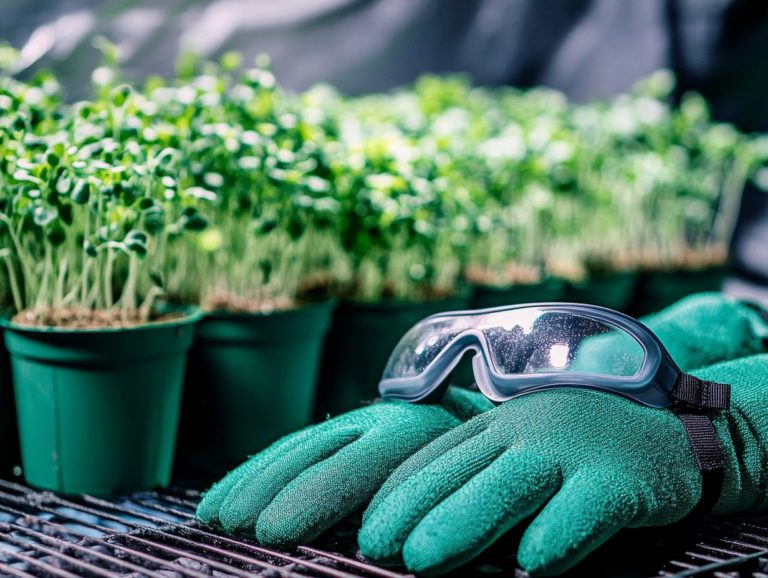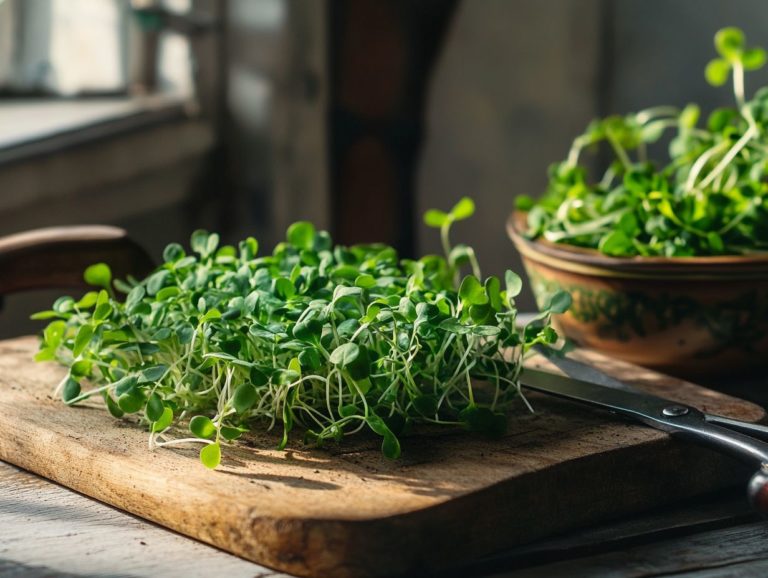Choosing the Right Growing Medium for Microgreens
Microgreens have gained immense popularity in the culinary realm. They are admired for their vibrant flavors and remarkable nutritional benefits. Cultivating these little greens at home not only adds a fresh, healthful touch to your meals but can also be a deeply rewarding experience.
Selecting the right growing medium is essential for their success, especially when considering various growing options.
This article delves into the advantages of microgreens, outlines the key factors to consider when choosing a growing medium, and compares various options. This guide will help you create a flourishing indoor garden.
Whether you re an accomplished gardener or just starting your journey, get ready to uncover exciting tips to elevate your growing experience.
Contents
- Key Takeaways:
- Benefits of Growing Microgreens
- Factors to Consider When Choosing a Growing Medium
- Types of Growing Mediums
- Soil
- Peat Moss
- Coco Coir
- Vermiculite
- Comparing Different Growing Mediums
- Frequently Asked Questions
- Curious about microgreens? Here s what you need to know!
- Why is choosing the right growing medium important for microgreens?
- What are the different types of growing mediums for microgreens?
- Which growing medium is best for beginners?
- Can I reuse growing mediums for microgreens?
- Is it possible to grow microgreens without a growing medium?
Key Takeaways:
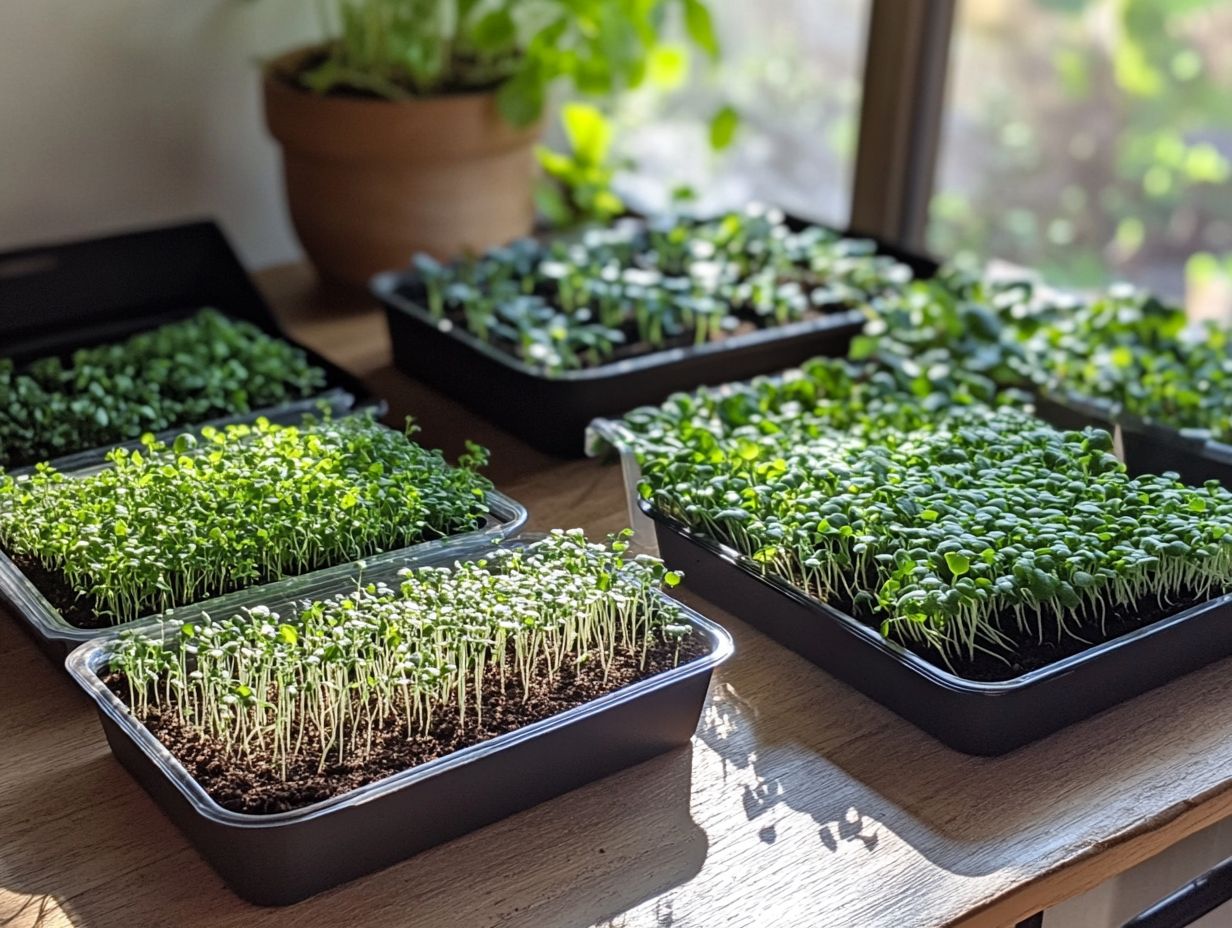
- Choose a growing medium suitable for the specific type of microgreen you’re growing, considering their nutritional needs and growth requirements.
- Consider environmental factors like temperature, humidity, and water retention when selecting a growing medium to ensure optimal growth for your microgreens.
- When comparing growing mediums, review their cost, availability, and effectiveness in providing the necessary nutrients and support for healthy microgreen growth.
What are Microgreens?
Microgreens are those vibrant, young edible plants you harvest just after the first leaves sprout. They re bursting with flavor and nutrients, making them a favorite among Home Microgreens enthusiasts.
You can grow these nutrient-dense crops from various seed varieties such as Komatsuna, Red Russian Kale, and Red Acre Cabbage. Each variety offers a delightful range of flavors for your culinary creations. Home Microgreens provides an excellent opportunity to cultivate these greens indoors or outdoors, allowing you to choose from various growing mediums that ensure optimal conditions for plant roots to thrive. To achieve the best results, it’s crucial to understand the perfect light conditions for microgreens.
The growth stages of microgreens begin with sprouting, where the seeds absorb moisture. This is followed by the emergence of cotyledons, which are the first leaves that appear. As they continue to develop, microgreens typically reach maturity in about a week, making them a quick and rewarding project for any gardener.
Beyond their zesty taste, growing them at home allows you to enjoy fresh greens whenever you please, while relishing the satisfaction that comes from nurturing your plants.
By incorporating a nutrient solution such as Ocean Solution, you can enhance their growth, providing essential elements for robust development. This ultimately leads to healthier greens packed with beneficial vitamins and minerals, elevating your gardening game to the next level.
Benefits of Growing Microgreens
Growing microgreens offers a wealth of benefits, from their remarkable nutritional value to the simplicity of their cultivation and their versatility in various dishes. These tiny powerhouses are rich in vitamins and minerals, making them a superb addition to any diet, especially when nurtured with organic fertilizer to boost their nutrient content.
They require minimal space and can thrive at various growth stages, making them ideal for urban gardening and home kitchens alike.
Nutritional Value and Convenience
Microgreens are celebrated for their exceptional nutritional value, often boasting higher levels of vitamins and antioxidants than their fully matured counterparts. Their ease of harvesting and preparation makes them an enticing option for health-conscious individuals, particularly if you re exploring organic fertilizer alternatives to enhance nutrient availability in your home gardening endeavors.
Not only do microgreens add a delightful burst of flavor and color to your dishes, but their concentrated nutrients also support your immune function and overall well-being. Their versatility allows you to seamlessly incorporate them into salads, smoothies, or even as garnishes, elevating your meals effortlessly.
With a diverse range of varieties from the peppery zing of arugula to the sweet tenderness of pea shoots there s a microgreen to satisfy every palate. This versatility makes them a valuable and healthful addition to your kitchen. With a little care and attention to soil health, these small yet mighty plants can offer significant health benefits that contribute to a balanced diet.
Start growing your own microgreens today and don t miss out on these amazing health benefits!
Factors to Consider When Choosing a Growing Medium
When you re selecting a growing medium for microgreens, it s important to consider several crucial factors, including soil quality, how well water drains, and how well it holds water. The right growing medium can significantly impact the health of your plant roots and nutrient availability. Choose a nutrient blend a mix of nutrients that help plants grow that supports optimal growth.
Options like compost or soilless mixes, such as Terrafibre Hemp or coco coir, can be customized to meet your specific needs. These provide a solid foundation for your successful home microgreens cultivation, especially when you know how to choose the right soil for microgreen growth.
Type of Microgreens
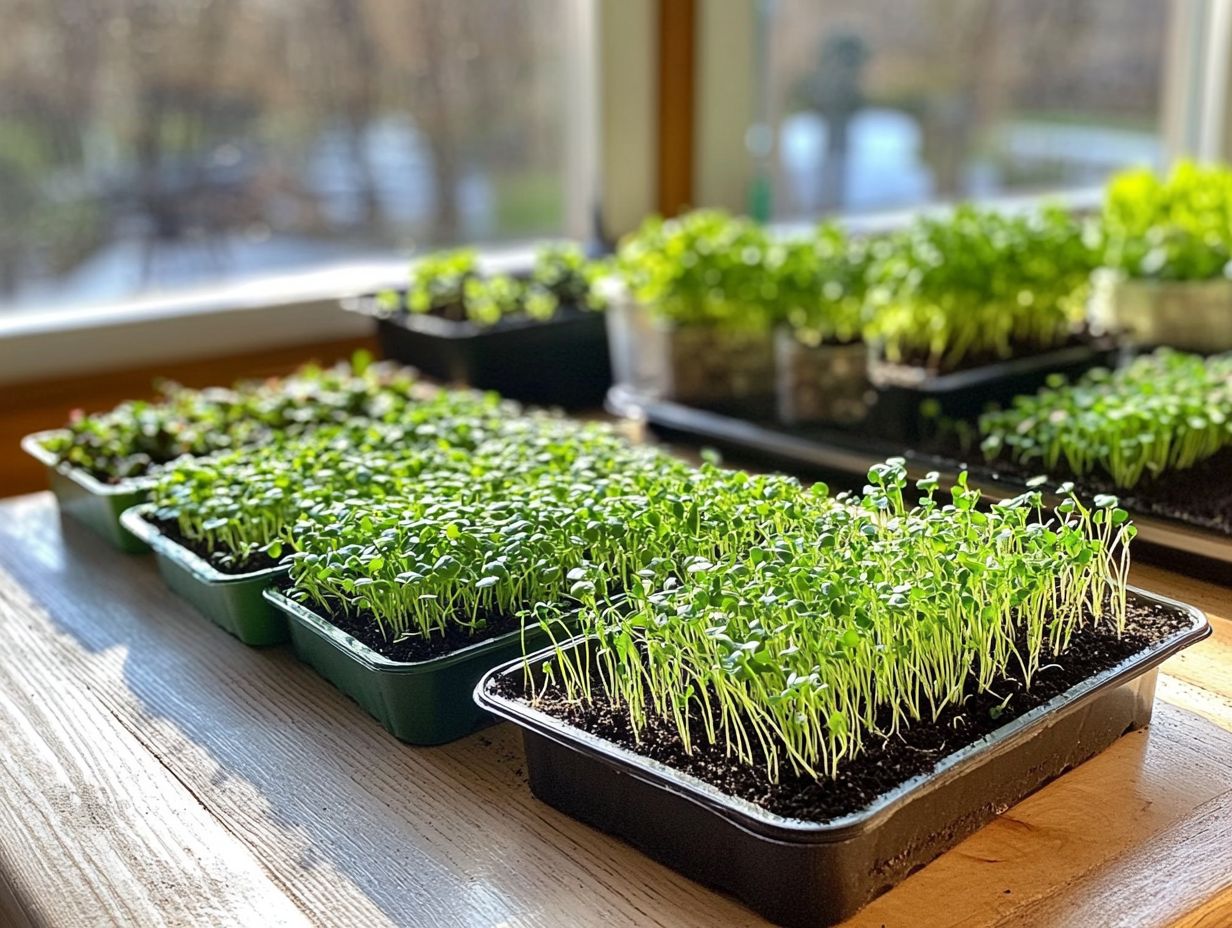
The microgreens you decide to grow can significantly influence both the flavor and nutritional profile of your dishes. Consider popular seed varieties like Komatsuna, Red Russian Kale, and Red Acre Cabbage. Each of these microgreens boasts unique characteristics that cater to various culinary applications, making them favorites among both home gardeners and chefs.
Take Komatsuna, for example. It offers a mild, slightly spicy flavor that s perfect for salads or as a garnish on sandwiches. On the other hand, Red Russian Kale introduces a subtle sweetness that elevates stir-fries and smoothies.
Then there’s the vibrant Red Acre Cabbage, with its striking color and crunchy texture, adding delightful crispness to tacos and sushi rolls. Beyond their appealing taste, these microgreens are nutritional powerhouses, brimming with vitamins A, C, and K, along with essential minerals. They aren t just a vibrant addition to your plate; they re a smart, health-conscious choice as well.
Environmental Factors
Environmental factors are crucial for the successful growth of your microgreens, shaping both their development and yield. It’s essential to maintain optimal moisture levels and ensure that your growing medium retains enough water to support the plant roots and promote healthy growth.
Light intensity and duration are critical for growth. Too little light can stunt their growth, while too much may lead to wilting. Humidity levels are equally important; high humidity can help delicate seedlings retain moisture, but it can also invite mold if not managed properly.
Maintaining an ideal temperature range typically between 65 F and 75 F is key to encouraging optimal photosynthesis and growth rates. By closely monitoring these environmental conditions, you can significantly enhance the vitality and flavor of your microgreens.
Types of Growing Mediums
In terms of cultivating microgreens, you have a variety of growing mediums at your disposal, each with unique properties and advantages tailored to different growing methods.
Traditional soil delivers essential nutrients that plants crave. Peat moss excels in moisture retention, making it a favored choice among many gardeners.
For those seeking lightweight options, coco coir and vermiculite are both excellent choices, promoting optimal drainage.
If you’re looking to maximize growth potential without soil, hydroponic solutions offer a compelling soilless alternative that can truly elevate your gardening experience.
Don’t wait; the right growing medium can transform your microgreens! Experiment with these options to discover what works best for you.
Soil
Soil serves as the essential foundation for growing microgreens, providing a rich array of nutrients crucial for their development.
The quality of the soil you choose can make a significant difference in drainage and overall plant health.
By utilizing well-aerated compost, you can enhance the nutrient content and help your plants grow better, ensuring that the roots have access to the vital components they need.
The composition of your soil is critical; it must retain moisture while allowing for excess drainage, which is vital to preventing root rot.
A balanced mix of organic matter, such as compost, improves soil structure, enhances aeration, and enriches nutrient availability.
This compost not only supplies essential tiny nutrients but also introduces beneficial microorganisms that bolster soil health.
By incorporating compost into your growing medium, you can create an optimal environment for your microgreens! This compost quality is essential for maintaining nutrient availability.
Peat Moss
Peat moss is your go-to lightweight growing medium, celebrated for its remarkable moisture retention capabilities. This makes it an ideal choice for nurturing microgreens.
This organic wonder not only holds water efficiently but also boasts an airy structure that supports healthy root growth, ensuring your young plants absorb nutrients optimally.
Its fibrous composition promotes excellent aeration, a critical factor in preventing root rot and encouraging vigorous growth.
With a slightly acidic pH, peat moss is beneficial for many plant species, enhancing their overall health.
Plus, its moisture-retaining ability reduces the need for frequent watering, creating a more forgiving environment for those new to gardening.
As a result, this growing medium paves the way for a flourishing microgreen garden, allowing you to reap a bountiful harvest with ease and enjoyment!
Coco Coir
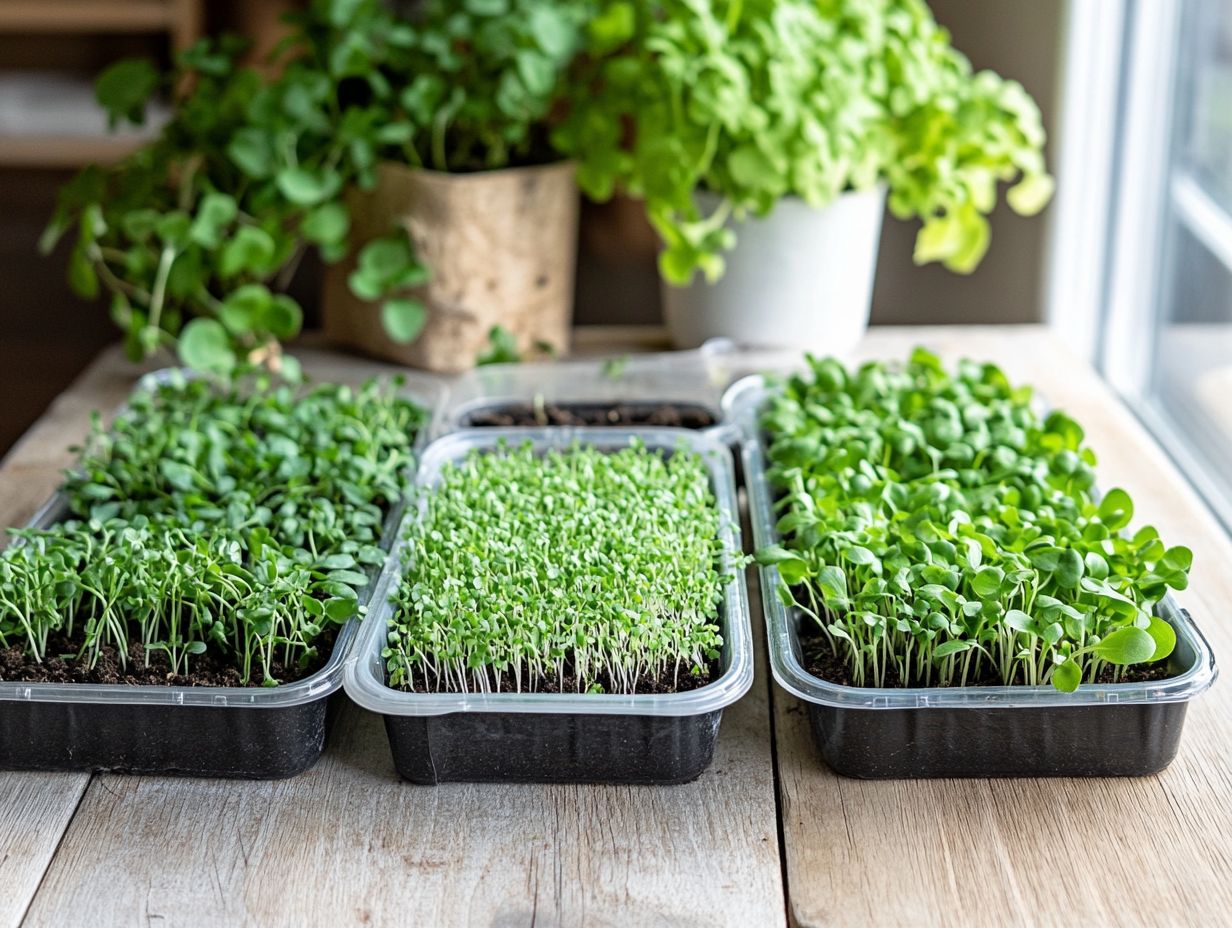
Coco coir is a sustainable growing medium crafted from coconut husks, renowned for its exceptional drainage properties and remarkable ability to retain moisture.
Its fibrous texture not only supports robust root growth but also creates an optimal environment for microgreens, making it a top choice for eco-conscious gardeners eager to cultivate their greens responsibly.
This natural resource does more than just promote vigorous plant development; it also enhances soil health significantly.
By effectively retaining moisture, coco coir minimizes the need for frequent irrigation especially advantageous in arid regions.
As a renewable product, it greatly reduces environmental impact compared to traditional peat-based mediums, appealing to those dedicated to sustainable practices.
This is especially true for gardeners looking into Home Microgreens and growing options.
Using coco coir fosters healthier plant ecosystems, ensuring that your plants thrive while embracing a more responsible gardening approach!
Vermiculite
Vermiculite is a lightweight, sterile medium that truly shines when it comes to enhancing drainage while retaining moisture. This makes it a standout choice for cultivating microgreens.
This mineral-based substrate not only encourages healthy root growth but also improves aeration, providing your plant roots with the essential space they need to flourish.
It absorbs and releases moisture well. This keeps your plants consistently hydrated, which means you can reduce the frequency of watering and minimize the risk of over-saturation.
This balance is particularly vital for delicate seedlings, as it alleviates stress and supports vigorous growth.
As a pH-neutral medium, vermiculite is simply a balanced level of acidity that s good for plants and supplies essential nutrients that contribute to overall plant vitality.
Its insulating properties help regulate temperature, creating a stable environment that promotes optimal growth.
Vermiculite s water retention and drainage capabilities are unmatched, making it an essential choice for seeding microgreens!
Hydroponic Solutions
Hydroponic solutions offer a cutting-edge approach to cultivating microgreens without the need for soil. This method utilizes water with nutrients to nourish plants directly. This soilless method grants you precise control over plant nutrients and growing conditions, enabling accelerated growth rates and higher yields compared to traditional practices.
By employing systems that deliver essential nutrients right to the roots, you can maximize nutrient absorption while minimizing waste. The ability to customize nutrient solutions for different microgreen varieties ensures optimal growth, flavor, and nutritional content tailored to your preferences.
Hydroponic methods also significantly reduce the risk of soil-borne diseases, presenting a cleaner and more sustainable option for cultivation. Many enthusiasts find these techniques particularly appealing for their adaptability in limited spaces, making urban farming or home gardening completely feasible. Utilizing nutrient solutions in hydroponics can enhance microgreen yields while ensuring nutrient availability.
Hydroponic systems for microgreens not only boost your efficiency but also encourage healthier eating habits something you can truly savor.
Comparing Different Growing Mediums
When evaluating various growing mediums for microgreens, you must consider cost, availability, and effectiveness to identify the ideal match for your gardening aspirations. Each medium be it traditional soil or hydroponics brings its own set of advantages and limitations. It s vital to align your choice with your growing objectives and budget to ensure a successful gardening experience.
Also, think about how compost quality and soil quality can influence your overall results.
Cost, Availability, and Effectiveness
Evaluating the cost, availability, and effectiveness of various growing mediums is essential for your success in cultivating microgreens, as each option can significantly influence your gardening experience. From budget-friendly choices like compost to specialized products such as Terrafibre Hemp grow mats and bamboo grow mats, understanding these factors will enable you to make informed product recommendations tailored to your specific needs.
By comparing elements such as nutrient retention, drainage capabilities, and the ease of sourcing these materials, you can determine which medium aligns best with your individual gardening goals. For example, while peat moss provides excellent aeration and water retention, its environmental sustainability has come under scrutiny. On the other hand, coconut coir, derived from coconut husks, offers an eco-friendly alternative with similar benefits. If you’re interested in growing microgreens, consider checking out these essential tips for growing microgreens at home.
If convenience is your priority, consider pre-made kits that include a mix of soil and nutrients to streamline the growing process. Ultimately, assessing these variables enhances your growth outcomes and ensures a more rewarding gardening journey.
Frequently Asked Questions

Curious about microgreens? Here s what you need to know!
Microgreens are small, immature plants that are harvested when they are only a few inches tall. They are packed with nutrients and are commonly used as a garnish or added to salads, sandwiches, and other dishes for added flavor and nutrition.
Why is choosing the right growing medium important for microgreens?
The growing medium is where the microgreens will get their nutrients and support for growth. It is important to choose the right one to ensure healthy and vibrant microgreens.
What are the different types of growing mediums for microgreens?
Some common types of growing mediums for microgreens include soil, peat moss, coconut coir, and hydroponic mats. Each has its own advantages and disadvantages, so it is important to research and choose the best one for your specific needs.
Which growing medium is best for beginners?
For beginners, we recommend using soil as the growing medium for microgreens. It is easily accessible and provides a good balance of nutrients for the microgreens to thrive.
Can I reuse growing mediums for microgreens?
Yes, some growing mediums like soil and coconut coir can be reused for multiple batches of microgreens. However, it is important to sterilize the medium between each use to prevent the growth of harmful bacteria and fungus.
Is it possible to grow microgreens without a growing medium?
Yes, you can grow microgreens without soil by using a method that involves growing plants in water. You can place the seeds on a moist mat made of materials like bamboo or jute.
This method involves providing a constant supply of nutrient-rich water. It may require more care, so it s better suited for those who are a bit experienced.
Growing microgreens without soil is a fun and innovative way to enjoy fresh greens at home!

